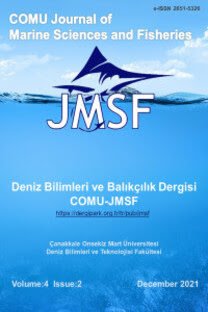Akyatan Lagünü (Karataş, Adana) Diyatom ve Dinoflagellat Topluluklarının Zamansal Değişimi
Akyatan Lagünü, Fitoplankton, Diyatom, Dinoflagellat, Zamansal Değişim
Temporal Variations of Diatom and Dinoflagellate Communities of Akyatan Lagoon (Karataş, Adana)
Akyatan Lagoon, Phytoplankton, Diatom, Dinoflagellate, Temporal Change,
___
- Kaynaklar
- Adana İli Çevre Durum Raporu, (2016). T.C. Çevre ve Şehircilik Bakanlığı, Çevre ve Şehircilik İl Müdürlüğü, 157 s.
- APHA, (1980). Standard Methods For the Examination of Water and Wastewater. APHA-AWWA-WPCF.15 th. Edition. Washington.
- Caroppo, C. (2000). The contribution of picophytoplankton to community structure in a Mediterranean brackish environment. Journal of Plankton Research, 22(2), 381-397.
- Çevik, F., Polat, S. & Dural, M. (2008). Akyatan ve Tuzla lagünlerinin (Adana, Türkiye) fitoplanktonu ve mevsimsel değişimi, Journal of Fisheries Sciences, 2(1), 19-29.
- Demir, A. (2008). Akyatan Lagününde Tuzluluk ve Bazı Kirlilik Düzeylerinin Saptanarak Coğrafi Bilgi Sistemi Destekli Dağılımlarının Belirlenmesi. Yüksek Lisans tezi, Adana: Çukurova Üniversitesi Fen Bilimleri Enstitüsü.
- Demir, A. & Selek, Z. (2009). Akyatan Lagünü’nde tuzluluk değişiminin mevsimsel izlenmesi, Ç.Ü. Müh. Mim. Fak. Dergisi, 24, 1-2, 165-178.
- Egemen, Ö., Önen, M., Büyükışık, B., Hoşsucu, B., Sunlu U., Gökpınar, Ş. & Cirik, S. (1999). Güllük Lagünü ekosistemi, Türkiye Journal of Agriculture and Forestry, 23(3),927-947.
- El Madani, F., Chiaar, A. & Chafi, A. (2011). Phytoplankton composition and abundance assessment in the Nador lagoon (Mediterranean coast of Morocco). Acta Bot. Croat. 70 (2), 269–288.
- Fanuko, N. & Valcıc, M. (2009). Phytoplankton composition and biomass of the northern Adriatic lagoon of Stella Maris, Croatia. Acta Bot. Croat. 68 (1), 29–44.
- Grasshoff, K., Kremlıng, K. & Ehrhardt, M. (1998). Methods of Seawater Analysis. Third edition, Wiley-VCH, 600 p.
- Hlaili, A.S., Grami, B., Niquil, N., Gosselin, M., Hamel, D., Troussellier, M. & Mabrouk, H.H. (2008). The planktonic food web of the Bizerte lagoon (south-western Mediterranean) during summer: I. Spatial distribution under different anthropogenic pressures. Estuarine, Coastal and Shelf Science, 78 (1), 61-77.
- Orman ve Su İşleri Bakanlığı ve Doğa Araştırmaları Derneği (2013). Akyatan ve Tuzla Lagünleri Yönetim Planı (2013-2017). 170 sayfa.
- Sahraoui, I., Bouchouıcha, D., Mabrouk H.H. & Hlaili, A.S. (2013). Driving factors of the potentially toxic and harmful species of Prorocentrum Ehrenberg in a semi-enclosed Mediterranean lagoon (Tunisia, SW Mediterranean). Mediterranean Marine Science, 14/2: 353-362.
- Sarno, D., Zingone, A., Saggiomo, V. & Carrada, G.C. (1993). Phytoplankton biomass and species composition in a Mediterranean coastal lagoon. Hydrobiologia, 271(1), 27-40.
- Sönmez M.E. & Artuk, C. (2011). Akyatan Lagünü Çevresinde Arazi Kullanımındaki Değişimlerim Zamansal İncelenmesi ve Ekosistem Üzerindeki Olumsuz Etkilerinin Belirlenmesi. Sosyal Bilimler Dergisi, Cilt 1, Sayı 1, 25-39.
- Strickland, J.D.H. & Parsons, T.R. (1972). A Practical Handbook of Seawater Analysis. Bull. Fish Res. Board. Can.,167, Ottawa, 310 p.
- WWF-Türkiye. (2008). Türkiye’deki Ramsar alanları değerlendirme raporu, WWF- Türkiye (Doğal Hayatı Koruma Vakfı), 129 s.
- Yayın Aralığı: 2
- Başlangıç: 2018
- Yayıncı: Çanakkale Onsekiz Mart Üniversitesi Deniz Bilimleri ve Teknolojisi Fakültesi
İldeniz PINAR, Sukran YALÇIN OZDİLEK
Serpil ODABAŞI, Semra CİRİK, Naime ARSLAN
Akyatan Lagünü (Karataş, Adana) Diyatom ve Dinoflagellat Topluluklarının Zamansal Değişimi
Büyükeceli Sahilindeki (Kuzey-Doğu Akdeniz) Centrolophus niger (Gmelin, 1789)’in Yeni Lokalite Kaydı
Deniz ERGÜDEN, Deniz AYAS, Nuray ÇİFTÇİ, Mısra BAKAN
İbrahim Ender KÜNİLİ, Fatma Arık ÇOLAKOĞLU
Titanyum Dioksit ve Nano Titanyum Dioksit Kullanımının Su Ürünlerine Olası Zararları
